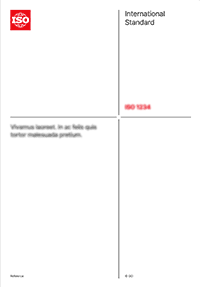Тезис
This document specifies requirements for the integration of industrial robot applications and industrial robot cells. The following are addressed:
— the design, integration, commissioning, operation, maintenance, decommissioning and disposal;
— integration of machines and components;
— information for use for the design, integration, commissioning, operation, maintenance, decommissioning and disposal.
This document is not applicable to the following uses and applications of industrial robots:
— underwater;
— law enforcement;
— military (defence);
— airborne and space, including outer space;
— medical;
— healthcare of a person;
— prosthetics and other aids for the physically impaired;
— service robots, which provide a service to a person and as such the public can have access;
— consumer products, as this is household use to which the public can have access;
— lifting or transporting people;
— multi-purpose lifting devices or machinery, e.g. cranes, forklift trucks.
NOTE Applications for the automation of laboratories are not considered as medical or healthcare of a person.
This document deals with the significant hazards, hazardous situations or hazardous events when used as intended and under specified conditions of misuse which are reasonably foreseeable by the integrator.
This document provides basic requirements for industrial robot applications, but does not cover the hazards related to the following:
— emission of airborne noise;
— severe conditions (e.g. extreme climates, freezer use, strong magnetic fields) outside of manufacturer’s specifications;
— underground use;
— use that has hygienic requirements;
— processing of any material (e.g. food, cosmetics, pharmaceutical, metal);
— use in nuclear environments;
— use in potentially explosive environments;
— mobility when robots or manipulators are integrated with driverless industrial trucks;
— mobility when robots or manipulators are integrated with mobile platforms;
— use in environments with hazardous ionizing and non-ionizing radiation levels;
— hazardous ionizing and non-ionizing radiation;
— handling loads the nature of which could lead to dangerous situations (e.g. molten metals, acids/bases, radiating materials);
— when the public or non-working adults have access.
Emission of acoustic noise could be identified to be a significant hazard, but emission of noise is not covered in this document.
Общая информация
-
Текущий статус: ОпубликованоДата публикации: 2025-02Этап: Опубликование международного стандарта [60.60]
-
Версия: 2
-
Технический комитет :ISO/TC 299ICS :25.040.30
- RSS обновления
Жизненный цикл
-
Ранее
ОтозваноISO 10218-2:2011
-
Сейчас
-
00
Предварительная стадия
-
10
Стадия, связанная с внесением предложения
-
20
Подготовительная стадия
-
30
Стадия, связанная с подготовкой проекта комитета
-
40
Стадия, связанная с рассмотрением проекта международного стандарта
-
50
Стадия, на которой осуществляется принятие стандарта
-
60
Стадия, на которой осуществляется публикация
-
90
Стадия пересмотра
-
95
Стадия, на которой осуществляется отмена стандарта
-
00


